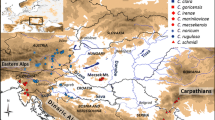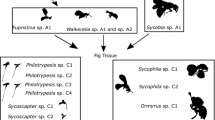Abstract
Comparative historical biogeography of multiple symbionts occurring on a common host taxa can shed light on the processes of symbiont diversification. Myrmecophytic Macaranga plants are associated with the obligate mutualistic symbionts: Crematogaster (subgenus Decacrema) ants and Coccus scale insects. We conduct phylogeographic analyses based on mitochondrial cytochrome oxidase I (COI) from 253 scale insects collected from 15 locations in Borneo, Malaya and Sumatra, to investigate the historical biogeography of the scales, and then to draw comparisons with that of the symbiotic, but independently dispersing, Decacrema ants which are not specific to different Coccus lineages. Despite the different mode of ancient diversification, reconstruction of ancestral area and age estimation on the Coccus phylogeny showed that the scales repeatedly migrated between Borneo and Malaya from Pliocene to Pleistocene, which is consistent with the Decacrema ants. Just as with the ants, the highest number of lineages in the scale insects was found in northern northwest Borneo, suggesting that these regions were rainforest refugia during cool dry phases of the Pleistocene. Overall, general congruence between the Plio–Pleistocene diversification histories of the symbiotic scales and ants suggests that they experienced a common history of extinction/migration despite their independent mode of dispersal and host-colonization.



Similar content being viewed by others
References
Althoff DM, Svensson GP, Pellmyr O (2007) The influence of interaction type and feeding location on the phylogeographic structure of the yucca moth community associated with Hesperoyucca whipplei. Mol Phylogenet Evol 43:398–406. doi:10.1016/j.ympev.2006.10.015
Avise JC (1994) Molecular markers, natural history and evolution. Chapman and Hall, New York
Avise JC (2000) Phylogeography: the history and formation of species. Harvard University Press, Cambridge, Mass.
Bänfer G, Moog U, Fiala B, Mohamed M, Weising K, Blattner FR (2006) A chloroplast genealogy of myrmecophytic Macaranga species (Euphorbiaceae) in Southeast Asia reveals hybridization, vicariance and long-distance dispersals. Mol Ecol 15:4409–4424. doi:10.1111/j.1365-294X.2006.03064.x
Beltran M, Jiggins CD, Bull V, Linares M, Mallet J, McMillan WO, Bermingham E (2002) Phylogenetic discordance at the species boundary: comparative gene genealogies among rapidly radiating Heliconius butterflies. Mol Biol Evol 19:2176–2190
Benson WW (1985) Amazon ant–plants. In: Prance GT, Lovejoy TE (eds) Key environments: Amazonia. Pergamon, Oxford, pp 239–266
Davies SJ (2001) Systematics of Macaranga sect. Pachystemon and Pruinosae (Euphorbiaceae). Harv Pap Bot 6:371–448
Davies SJ, Lum SKY, Chan R, Wang LK (2001) Evolution of myrmecophytism in western Malesian Macaranga (Euphorbiaceae). Evolution 55:1542–1559. doi:10.1554/0014-3820(2001)055[1542:EOMIWM]2.0.CO;2
Degnan PH, Lazarus AB, Brock CD, Wernegreen JJ (2004) Host-symbiont stability and fast evolutionary rates in an ant–bacterium association: cospeciation of Camponotus species and their endosymbionts, Candidatus Blochmannia. Syst Biol 53:95–110. doi:10.1080/10635150490264842
Federle W, Maschwitz U, Fiala B (1998) The two-partner ant–plant system of Camponotus (Colobopsis) sp 1 and Macaranga puncticulata (Euphorbiaceae): natural history of the exceptional ant partner. Insectes Soc 45:1–16. doi:10.1007/s000400050064
Fiala B, Maschwitz U (1990) Studies on the South East-Asian ant–plant association Crematogaster borneensis/Macaranga: adaptations of the ant partner. Insectes Soc 37:212–231. doi:10.1007/BF02224049
Fiala B, Maschwitz U, Pong TY, Helbig AJ (1989) Studies of a Southeast Asian ant–plant association: protection of Macaranga trees by Crematogaster borneensis. Oecologia 79:463–470. doi:10.1007/BF00378662
Fiala B, Jakob A, Maschwitz U (1999) Diversity, evolutionary specialization and geographic distribution of a mutualistic ant–plant complex: Macaranga and Crematogaster in South East Asia. Biol J Linn Soc Lond 66:305–331
Gaunt MW, Miles MA (2002) An insect molecular clock dates the origin of the insects and accords with palaeontological and biogeographic landmarks. Mol Biol Evol 19:748–761
Gorog AJ, Sinaga MH, Engstrom MD (2004) Vicariance or dispersal? Historical biogeography of three Sunda shelf murine rodents (Maxomys surifer, Leopoldamys sabanus and Maxomys whiteheadi). Biol J Linn Soc Lond 81:91–109. doi:10.1111/j.1095-8312.2004.00281.x
Guindon S, Gascuel O (2003) A simple, fast, and accurate algorithm to estimate large phylogenies by maximum likelihood. Syst Biol 52:696–704. doi:10.1080/10635150390235520
Gullan PJ (1997) Relationships with ants. In: Ben-Dov Y, Hodgson CJ (eds) Soft scale insects-Their biology, natural enemies and control. Elsevier, Amsterdam, pp 351–373
Gwiazdowski RA, Van Driesche RG, Desnoyers A, Lyon S, Wu SA, Kamata N, Normark BB (2006) Possible geographic origin of beech scale, Cryptococcus fagisuga (Hemiptera: Eriococcidae), an invasive pest in North America. Biol Control 39:9–18. doi:10.1016/j.biocontrol.2006.04.009
Hall R (2001) Cenozoic reconstructions of Southeast Asia and the SW Pacific: changing patterns of land and sea. In: Metcalfe I, Smith JMB, Morwood M, Davidson I (eds) Faunal and floral migrations and evolution in SE Asia–Australia. Swets & Zeitlinger, Lisse, pp 35–56
Heckroth HP, Fiala B, Gullan PJ, Idris AH, Maschwitz U (1998) The soft scale (Coccidae) associates of Malaysian ant–plants. J Trop Ecol 14:427–443. doi:10.1017/S0266467498000327
Hodgson CJ (1994) The scale insect family Coccidae: an identification manual to genera. CAB International, Wallingford
Huelsenbeck JP, Rannala B (1997) Phylogenetic methods come of age: testing hypotheses in an evolutionary context. Science 276:227–232. doi:10.1126/science.276.5310.227
Huelsenbeck JP, Ronquist F (2001) MRBAYES: Bayesian inference of phylogenetic trees. Bioinformatics 17:754–755. doi:10.1093/bioinformatics/17.8.754
Inger RF, Voris HK (2001) The biogeographical relations of the frogs and snakes of Sundaland. J Biogeogr 28:863–891. doi:10.1046/j.1365-2699.2001.00580.x
Kershaw AP, Penny D, van der Kaars S, Anshari G, Thamotherampillai A (2001) Vegetation and climate in lowland southeast Asia at the Last Glacial Maximum. In: Melcalfe I, Smith JMB, Morwood M, Davidson I (eds) Floral and faunal migrations and evolution in Southeast Asia–Australasia. Balkema, Lisse, pp 227–236
Kumar S, Tamura K, Jakobsen IB, Nei M (2001) MEGA 2.1: molecular evolutionary genetics analysis software. Bioinformatics 17:1244–1245. doi:10.1093/bioinformatics/17.12.1244
Linnen CR, Farrell BD (2007) Mitonuclear discordance is caused by rampant mitochondrial introgression in Neodiprion (Hymenoptera: Diprionidae) sawflies. Evolution 61:1417–1438. doi:10.1111/j.1558-5646.2007.00114.x
Mckey D (1989) Interaction between ants and leguminous plants. In: Stirton CH, Zarucchi JL (eds) Advances in legume biology. Monographs in Systematic Biology, vol 29. Missouri Botanical Garden, St. Louis, pp 673–718
Medway G (1972) The Quaternary mammals of Malesia: a review. In: Ashton PS, Ashton M (eds) The Quaternary Era in Malesia Transactions of the 2nd Aberdeen-Hull Symposium on Malesian Ecology. University of Hull Department of Geography Miscellaneous Series no. 13, Hull, pp 63–83
Moog J, Saw LG, Hashim R, Mascwitz U (2005) The triple alliance: how a plant ant, living in an ant–plant, acquires the third partner, a scale insect. Insectes Soc 52:169–176. doi:10.1007/s00040-005-0791-3
Morley RJ (2000) Origin and evolution of tropical rain forests. Wiley, Chichester
Mueller UG, Rehner SA, Schultz TR (1998) The evolution of agriculture in ants. Science 281:2034–2038. doi:10.1126/science.281.5385.2034
Mueller UG, Schultz TR, Currie CR, Adams RM, Malloch D (2001) The origin of the attine ant–fungus mutualism. Q Rev Biol 76:169–197. doi:10.1086/393867
Nieberding CM, Olivieri I (2007) Parasites: proxies for host genealogy and ecology? Trends Ecol Evol 22:156–165. doi:10.1016/j.tree.2006.11.012
Nieberding CM, Durette-Desset MC, Vanderpoorten A, Casanova JC, Ribas A, Deffontaine V, Feliu C, Morand S, Libois R, Michaux JR (2008) Geography and host biogeography matter for understanding the phylogeography of a parasite. Mol Phylogenet Evol 47:538–554. doi:10.1016/j.ympev.2008.01.028
Posada D, Crandall KA (1998) MODELTEST: testing the model of DNA substitution. Bioinformatics 14:817–818. doi:10.1093/bioinformatics/14.9.817
Quek SP, Davies SJ, Itino T, Pierce NE (2004) Codiversification in an ant–plant mutualism: stem texture and the evolution of host use in Crematogaster (Formicidae: Myrmicinae) inhabitants of Macaranga (Euphorbiaceae). Evolution 58:554–570. doi:10.1554/03-361
Quek SP, Davies SJ, Ashton PS, Itino T, Pierce NE (2007) The geography of diversification in mutualistic ants: a gene’s-eye view into the Neogene history of Sundaland rain forests. Mol Ecol 16:2045–2062. doi:10.1111/j.1365-294X.2007.03294.x
Rambaut A, Charleston M (2002) TreeEdit. Phylogenetic Tree Editor v1.0 alpha 10. Department of Zoology, University of Oxford, Oxford
Ronquist F (1997) Dispersal-vicariance analysis: a new approach to the quantification of historical biogeography. Syst Biol 46:195–203. doi:10.2307/2413643
Sanderson MJ (1997) A nonparametric approach to estimating divergence times in the absence of rate constancy. Mol Biol Evol 14:1218–1231
Shimodaira H, Hasegawa M (1999) Multiple comparisons of log-likelihoods with applications to phylogenetic inference. Mol Biol Evol 16:1114–1116
Simon C, Frati F, Beckenbach A, Crespi B, Liu H, Flook P (1994) Evolution, weighting, and phylogenetic utility of mitochondrial gene sequences and a compilation of conserved polymerase chain reaction primers. Ann Entomol Soc Am 87:651–701
Sota T, Vogler AP (2001) Incongruence of mitochondrial and nuclear gene trees in the Carabid beetles Ohomopterus. Syst Biol 50:39–59. doi:10.1080/713849547
Swofford DL (2002) PAUP*: Phylogenetic Analysis Using Parsimony ver. 4.0b10. Sinauer Associates, Sunderland
Ueda S, Quek SP, Itioka T, Inamori K, Sato Y, Murase K, Itino T (2008) An ancient tripartite symbiosis of plants, ants and scale insects. Proc R Soc Lond B 275:2319–2326. doi:10.1098/rspb.2008.0573
Ward P (1991) Ant–plant interactions. In: Cutler D, Huxley CR (eds) Phylogenetic analysis of pseudomyrmecine ants associated with domatia-bearing plants. Oxford University Press, Oxford, pp 335–352
Whiteman NK, Kimball RT, Parker PG (2007) Co-phylogeography and comparative population genetics of the threatened Galapagos hawk and three ectoparasite species: ecology shapes population histories within parasite communities. Mol Ecol 16:4759–4773. doi:10.1111/j.1365-294X.2007.03512.x
Acknowledgments
We thank P. J. Gullan and T. Kondo for comments on the outgroup specimens; K. Inamori and Y. Sato for the analytical support; Y. Inui, C. Handa, T. Okubo, T. Komatsu and Y. Kataoka for sampling support; H. Tanaka for comments on Coccus; N. Pierce, A. Hamid, T. Fukatsu, T. Yokokawa, A. Kawakita, S. Usami, Y. Nakamura and S. Matsuda for analytical advice and/or technical support. This research was funded by the Japan Ministry of Education, Culture, Sports, Science and Technology (12640614 and 14540577 to T.I. and 177966 to S.U.). We thank Sabah Parks, National Parks Board (Singapore) and Sarawak Forest Department for collecting permission.
Author information
Authors and Affiliations
Corresponding author
Electronic supplementary material
Below is the link to the electronic supplementary material.
Rights and permissions
About this article
Cite this article
Ueda, S., Quek, SP., Itioka, T. et al. Phylogeography of the Coccus scale insects inhabiting myrmecophytic Macaranga plants in Southeast Asia. Popul Ecol 52, 137–146 (2010). https://doi.org/10.1007/s10144-009-0162-4
Received:
Accepted:
Published:
Issue Date:
DOI: https://doi.org/10.1007/s10144-009-0162-4




